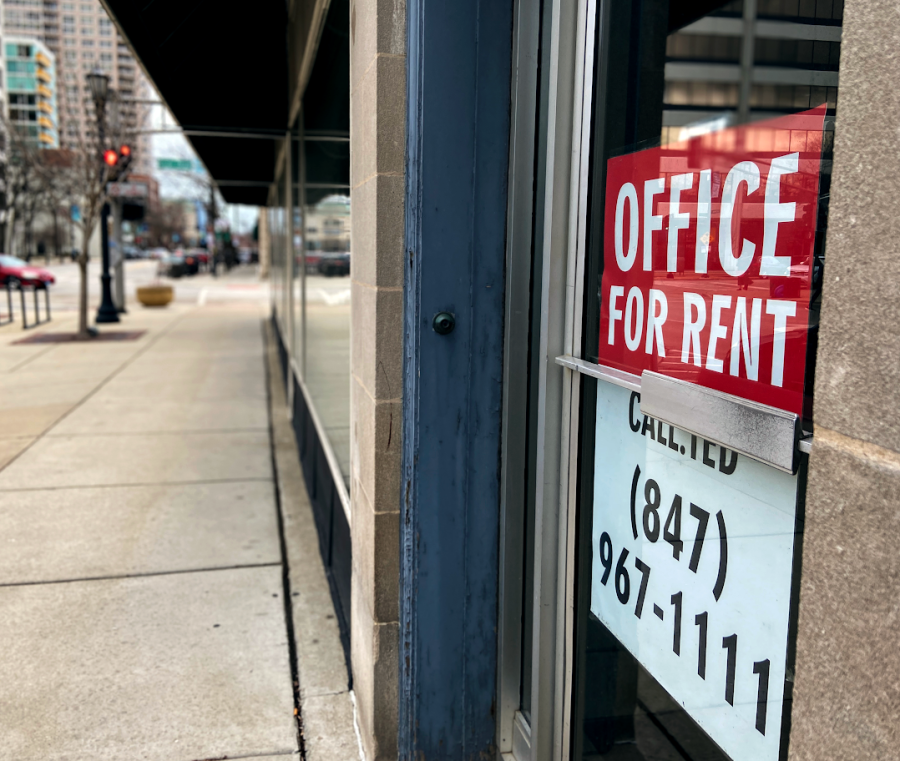‘A difference of philosophy’: leaders consider two visions for downtown Evanston’s future
Cole Reynolds/The Daily Northwestern
On its website, it says Little Beans’ last day of business will be closing on Sunday, Nov. 26.
April 2, 2023
Annie Coakley, director of Downtown Evanston, remembers a “liveliness” about downtown, filled with people eating their lunches at Fountain Square.
Now, that liveliness is gone, she said.
“You walk down Sherman Avenue in the evening, and it doesn’t feel great right now,” said Paul Zalmezak, the city’s economic development manager.
The city is reviewing plans to bring that liveliness back, including a proposal to invest in cultural and infrastructural improvements and one to fund small businesses affected by COVID-19.
Zalmezak said much of downtown’s downturn results from the pandemic, when its office vacancy rates jumped to 15.4% in December 2021, far outpacing that of Evanston’s other business districts. Businesses lacked foot traffic, said Coakley, as remote work sapped a key customer demographic.
Before the pandemic,15,000 to 20,000 office workers commuted downtown, Zalmezak said. But even the rosiest estimates from the city say just 60% have returned, a pattern mirrored in other downtowns similar to Evanston.
“That’s people,” Coakley said of downtown office workers. “People have money, and people spend money on lunch, on workouts, on haircuts — all the things you do when you work in a specific place.”
City officials have more than $6 million in unspent American Rescue Plan Act allocations meant to revitalize downtown. Ald. Clare Kelly (1st), who represents much of downtown, requested $2 million of those funds for the “Small Business Recovery and Growth Fund.”
The program provides grants up to $50,000 to businesses affected by the pandemic. Zalmezak said there is a chance office workers could return in the next three to five years on their own. According to Kelly, grants from her proposal could help small businesses weather those five years and adapt to the future.
“The positive impact (small businesses’) uniqueness and independent nature has on attractiveness and everything else in our city — that’s a big component,” she says.
But Zalmezak said Evanston must also prepare for a future where those workers never return. That’s why he and city staff recommended budgeting $500,000 to a small business support program, saving more funds for a separate program designed to focus on attracting a different downtown demographic.
Zalmezak endorses the “Evanston Thrives” plan, aiming to replace office workers as the downtown customer base.
“There’s a little bit of a difference of philosophy,” Zalmezak said. “But it’s all about the same thing. It’s about supporting small businesses.”
“Evanston Thrives” says downtown must become more approachable for Black residents, who only represent 8% of foot traffic in the district. The plan also tries to attract more Northwestern students, of which almost 18,000 live in Evanston and who could also help offset the loss of workers.
Catering to NU students has insulated Crossroads Trading Co. from the economic downturn. Manager Lizz Merdinger said the store’s business has actually doubled since the pandemic.
“We have to think of ways to get different people downtown,” Coakley said, although she also supports Kelly’s plan to provide payments to businesses.
A mixture of more publicly sponsored events and infrastructure improvements like streetscaping will attract those people, according to Zalmezak. The idea is to make downtown more walkable and provide more reasons to go there.
Housing, Zalmezak said, must also be the centerpiece of Evanston’s economic strategy to repopulate downtown. However, new housing is not a primary goal of “Evanston Thrives.”
Coakley agreed with housing increases, saying that residents also can patronize local businesses.
“Downtown is a downtown, but it’s also a neighborhood,” Coakley said. “(Residents) can walk to a grocery store. They can walk to a movie theater … the more we have people doing that, the better everybody is.”
But some longtime Evanston businesses are “frustrated” by what they see as the city abandoning them in a time of crisis.
Nina Barrett, the owner of Bookends & Beginnings, said her store already puts on multiple events per week, each drawing between 60 to 100 people downtown. She said established businesses deserve monetary support for their contributions to the area.
“‘Evanston Thrives’ consultants came up with things like ‘placemaking’ or ‘events,’” Barrett said. “Let’s reward the businesses who are already doing these things.”
Zalmezak said direct payments, like those included in Kelly’s plan, carry a lot of risk for the city. Funding is finite, he said, and the city could — and has — erred in determining which businesses should receive it.
He expressed concern about propping up otherwise unviable businesses, especially since city staff aren’t trained to make such decisions.
“When the city directly invests into a business, the city is basically choosing winners and losers,” Zalmezak said.
Instead, the city’s job is to provide the people and the infrastructure, he said. It would be up to residents of particular neighborhoods to choose the businesses they favor.
Kelly disagreed, saying city leaders know which businesses are valuable and are experienced in grant underwriting. “Evanston Thrives,” she said, is too “vague” in its funding goals. Elected officials, not city staff, Kelly told The Daily via text, should be setting the policies.
Regardless, Evanston holds inherent advantages, like the University and the lakefront, over surrounding areas, Zalmezak said. They ensure Evanston remains attractive for owners and brokers, Coakley said.
“I don’t even know if ‘recovery’ is the right word,” she said “(Downtown) will be reimagined.”
Correction: A previous version of this story misstated that city staff recommended cutting funding from Ald. Clare Kelly (1st)’s proposal. The staff made their funding proposal independent from Kelly. The Daily regrets the error.
Email: colereynolds2026@u.northwestern.edu
Twitter: @charcole27
Related Stories:
— City Council discusses allocation proposals for remaining ARPA funds
— Here’s how Evanston has allocated $38 million of its ARPA funding over the last two years
— AMC’s reopening brings convenience, excitement to downtown Evanston


